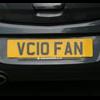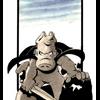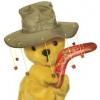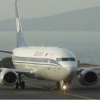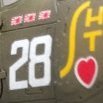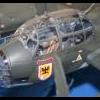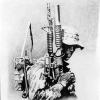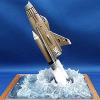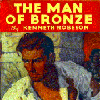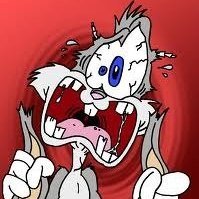Search the Community
Showing results for tags 'bronco'.
-
Bronco Models programme catalogue 2017-2018 is on approach. Source: http://www.armorama.com/modules.php?op=modload&name=News&file=article&sid=24755&mode=thread&order=0 V.P.
-
L3-35r Battalion HQ radio Command tank Libya, Summer 1940 Approximately 324 of these tankettes were available to the Italian Army at the beginning of hostilities in North Africa. Only HQ vehicles, though, would receive radio equipment. The loop antenna was the initial type, but would eventually be replaced by the standard vertical antenna, along with improved radios. The kit is one of Bronco's initial releases in the Italian tankette series, and was converted/upgraded to a radio version with a Brach Models resin kit. There were a few things scratch built, but most importantly the radio box inside the crew compartment. A WiP can be found in the Mediterranean GB section: regards, Jack
-
So my entry will be Bronco's CV3/35 tankette: It's a huge box for such a small vehicle, and there are 5 sets of sprues, along with a small clear plastic one for the headlight lenses. Pretty much a full interior is included, but I will have to scratch build some form of a communications radio. Will also use Brach Model's conversion set, most importantly for the loop antenna and exterior battery boxes. Upper hull structure is also much nicer with it's meatier bolts detail. I've put together a little graphic chart of 1939/40 light tank battalion, illustrating the allocation of radio tanks. Basically the HQ platoon of each company had one such vehicle, the tactical marking being a solid coloured rectangle. I have crossed out the battalion Commander as I'm not sure of the type of vehicle. The chart was based on some quoted reports discussed at ComandoSupremo forum, indicating the early tank battalion was composed of 46 L3 tankettes. I think I will go with the black tactical marking, don't see that one modeled very often. regards; Jack
-
With the darker nights setting in I have finally begun sorting out my 2016 digipix. These are some shots I took at Sacramento earlier in the year and show the S-2T Trackers and OV-10A/D Broncos in use by the Californian State Fire teams. By way of background here's the history of this aerial fire fighting unit. The possibility of using aircraft for fighting wildland fires in California was first proposed in 1931 and again in the late 1940’s after World War II. In the interveninhg years a number of ex mil types were utilised including O-2s and P-3 Orions. Currently with its HQ at the former McClelland AFB at Sacramento the Cal Fire emergency response air program includes 23 Grumman S-2T 1,200 gallon airtankers, 11 UH-1H Super Huey helicopters, and 14 OV-10A air tactical aircraft . From 13 air attack and nine helitack bases located across the state of California aircraft can reach most fires within 20 minutes. The past few years have seen the state of California suffer near drought conditions with the effect that much of the forestry and grasslands are tinderbox dry and raging fires are an unfortunate and sometimes tragic reality. The Cal Fire aerial firefighters are therefore kept extremely busy and maintained at a high state of readiness. The airtactical planes fly overhead directing the airtankers and helicopters to critical areas of the fire for retardant and water drops. The retardant used to slow or retard the spread of a fire is a slurry mix consisting of a chemical salt compound, water, clay or a gum-thickening agent, and a coloring agent. While both airtankers and helicopters are equipped to carry fire retardant or water, the helicopters can also transport firefighters, equipment and injured personnel. All CAL FIRE Aircraft are strategically located throughout the state at airbases and helicopter bases. During high fire activity, CAL FIRE may move aircraft to better provide statewide air support. The average annual budget of the CAL FIRE Aviation Management Program is nearly $20 million. A total of 18 CAL FIRE personnel oversee the program with an additional 130 contract employees providing mechanical, pilot and management services to the program. CAL FIRE's current support contractors are DynCorp and Logistics Specialties Incorporated (LSI). DynCorp provides airtanker and airtactical plane pilot services, and all aircraft maintenance services. (All CAL FIRE helicopters are flown by CAL FIRE pilots.) The main types by number used by Cal Fire and which are featured in this photo essay are the S-2T Tracker and OV-10A Bronco. The S-2T Tracker In 1996, CAL FIRE acquired 26 S-2E/G planes from the Department of Defense. CAL FIRE converted the planes to a fire fighting configuration and fitted them with modern, powerful turboprop engines. The completely reconditioned S-2Ts are faster, safer, more maneuverable, and carry a larger retardant payload than the S-2A airtankers CAL FIRE had used since the 1970s. The final three S-2Ts were completed and delivered in 2005. CAL FIRE has 23 S-2T airtankers. One is permanently stationed at the Sacramento Aviation Management Unit facility for maintenance relief. CAL FIRE uses the S-2T airtankers for fast initial attack delivery of fire retardant on wildland fires.The aircraft carry a crew of just one pilot. S-2T Tracker N442DF/94 was formerly US Navy BuNo 152826. S-26 N426DF ex USN BuNo 152824 Ex AMARG S-2E BuNo 149259 which is understood to have been acquired by CAL FIRE for conversion to S-2T to replace one of the unit's aircraft written off in 2014. The OV-10 Bronco Originally used by the U.S. Navy/Marines from 1968-1993, the OV-10A was used as a counter-insurgency aircraft and close air-support to military ground forces. In 1993, CAL FIRE acquired 15 OV-10A/Ds from the Department of Defense. Of those 15, 14 have been converted and are available for use as air attack planes. The OV-10s replaced the original Cessna 0-2As that CAL FIRE had been using for air attack. The OV-10s are newer, larger, faster, provide a larger field of vision for the crew and are more manueverable than the older O-2As. CAL FIRE uses the OV-10s as command and control of aircraft on wildland fires. The crew provides tactical coordination with the incident commander on the ground, providing information on the movement and spread of the fire. The OV-10 crew then directs CAL FIRE’s airtanker and helicopterpilots on where to make their retardant and water drops. OV-10A N400DF/410 ex BuNo 155454 OV-10D N470DF/505 ex BuNo 155502 Cockpit of OV-10 N413DF Believed to be for spares recovery is this OV-10D N6I7NA ex BuNo 155406. These three Huey cabs were also seen in a compound at the CAL FIRE facility and they comprise UH-1Vs 67-19494, 68-16115 and 69-15145. Hope this report was of interest. Some of the schemes would certainly make eye for some colourful models! C&C always welcome. Mark
-
Just rolls off the tongue doesn't it - no wonder it's known as Diana. Stages 1 and 2 - doing pretty well so far, only managed to lose 2 bits and replaced them, which is good going for a Bronco kit, so many small bits Then on with stage 3 - the main interlocked wheels, actually going together well so far Peter
-
Kit manufacture: Bronco Scale: 1/35 Type: Stagound Mk.I Extras used: Panzerart resin wheels and turret Paints and colours used: Tamiya and Vallejo Hi, here's my latest creation. It's Broncos Staghound Mk.I. A fine kit spiced up with resin wheels and camoflagued turret Any comments appreciated.
- 11 replies
-
- 17
-

-
G'Day All Latest one of the bench is the Bronco 1/48 H-81. Not one of my better jobs. This one took longer than a 48 scale single engine fighter should. I think because I ended up adding a true Details resin cockpit to correct the kits undersized one. The only gaps were the wing roots. Apart from that it assembled OK. the kit comes with an engine, but I could not display it as I wanted to, as the firewall is forward of where it should be. Apart from that I also added a Ultracast seat, and modified the awful representations of fabric control surfaces Bronco give you to better represent the real things. Bronco has moulded pronounced troughs between the ribs so I smoothed milliput over them. With the forthcoming Airfix kit, I reckon this one will not be much of a seller DSC_7128 , DSC_7133 , DSC_7111 by ,
- 5 replies
-
- 15
-

-
- flying tigers
- bronco
-
(and 1 more)
Tagged with:
-
Hi everyone! Yesterday I've taken Academy's Bronco box from the stash to build the Vietnam OV-10A and quite quickly came to the conclusion that the kit needs some improvements. Would love to listen to advice/experience of building this bird! First topic - undercarriage. Academy provides very basic undercarriage bays and very.... questionable and fiddly main gear. I was able to collect a number of photos of both bays and chassis, but couple of question remain unclear. #1. As far as I get it, the area in front of the cockpit was actually empty and was used to accommodate nose wheel, front taxiing lamp and some wiring. Such as like this. Is it the best way to just keep it empty, adding just the wiring and a bump for the front lamp? Or I'm missing something? #2. I'm seriously concerned about capability of Academy's plastic sticks representing main gear to keep the whole thing standing upright Moreover these sticks have nothing in common with actual main gear I do not see any metal/resin alternatives - so would be grateful if anybody could advice how to scratchbuild more or less reliable replacements Second topic - dimensional accuracy. From what I was able to learn from WIPs and comparison with photoes - Academy's model is pretty OK - the main area that is completely off is intakes above the propellers. Seems to be an easy fix though. Are the things really that good or I miss something major? Third topic - I've got the CMK's interior set and would love to use the vacformed canopy as I'm afraid of gluing together the fiddly thing from Academy. Does anybody have any experience of using CMK's canopy? Does it fit well or not really? Would be grateful for any advise before I start cutting it out. Dennis P.S. Almost forgot - where could I put enough weight to keep it standing on the wheels??? Nose bay seems to be unavailable for that
-
Hi guys and girls, I plan on making something involving these two boxs And this guy from alpine miniatures; Not sure what I'm going to do maybe the Jeep's diving through' and soldiers watching or Jeep stopped with the guy talking to the driver while others sitting around... I'll wait and see! May get a few more alpine figures. Also got some miniart tiles for the floor so abit of chopping will be in order! Thanks for looking! Joss
-
After its T-6, Kitty Hawk is to release a 1/32nd North American OV-10D Bronco kit - ref.KH32003 See CAD drawings herebelow Sources: http://www.themodellingnews.com/2014/01/yee-har-kittyhawk-to-let-loose-large.html https://fr-fr.facebook.com/Kagero.SM https://www.facebook.com/media/set/?set=ms.639006636156204.639006599489541.639006522822882.639006542822880.639006722822862.bps.a.639006416156226.1073741960.224979750892230&type=1 V.P.
-
Hi Folks. It's been a while since I did a WIP post and a little while since I got stuck into a well detailed project, so, with the trigger finger itching so to speak I've delved into German armour in the form of Tamiya's excellent Panther G-early. As is always the case when one suffers from that most terrible of afflictions, the dreaded AMS, I have plumped for several aftermarket items to help pop the kit out into something a touch more special. Items can be seen in the photo below and they are: RB models turned aluminium main barrel. RB models aerial mast and base. Attak resin zimm. Eureka models tow cables. eduard exterior detailing and Schurzen. Bronco working tracks. I've got the absolutely incredible Culver & Feists Panther in detail book as reference and I really cant stress how good this book is. There are no plans on a dio for her at the mo I'm just going to see how the project rolls along, same goes for crew. I'm skeptical about the Bronco tracks too and may end up with Friuls, again we'll see how we go. Any way I'm itching to get started so more progress to come. As always, advice, comments and criticism welcome and thanks for following along. Wagons roll! Ben.
-
OV-10A Bronco Testors 1:48 The Bronco was initially planned as a light attack, long loiter time aircraft with a span of 20ft that could operate from roads close to the combat zone, however it materialised with a much longer span of 40ft and heavier due to the specifications including avionics and ejection seats limiting its use to airfields. The twin boom aircraft first flew in 1965 and was destined to become a light armed reconnaissance & forward air control aircraft with the US Navy, Airforce and Marines. The need was bread out of the Cessna O-1 & O-2 becoming obsolete due to the limited performance. The requirement needed a two seat two engined aircraft that could carry over 2000lb of payload, 6 paratroopers or stretchers, high G tolerance and have a 350mph capability whilst being able to have a good loiter performance and STOL capability. The Marines were the first to take the OV-10 into service as a forward air controller operating in both night and day missions. Whilst the Bronco is most known for its operations in Vietnam, it also served in later conflicts as late on as the Gulf war where it received its last losses in US service before retiring in 1995. The USAF started to receive it's Bronco's in 1968 and was primarily used as forward air controllers. This was a varied role in itself, using smoke laying methods as well as later using laser target designators. Development also led to it carrying its own ground attack armament including rockets, machine guns and bombs to support ground movements. As well as a fairly small part played with the US Navy, seven export contracts were made, a few of which are still in service today with Venezuela. These included Germany, Columbia and Indonesia. Whilst it was an effective aircraft, it suffered from being underpowered, an issue that led to several aircraft being lost where it couldn't out climb the terrain. The Bronco has also seen non-military use in the war on drugs in South America as well as operating as a fire fighter. More recently, Boeing were looking into a new variant known as the OV-10X in 2009 as a modernised forward air control variant with the latest glass cockpit technology. There had been export interest in the possibility, however I'm unable to find any more news about how that proposal progressed. The kit If you're wanting to build a Bronco in 1/48, then you have a 'Hobsons Choice'. This is the old Italeri / Testors kit re-released. On opening the box, you're presented with the parts all wrapped up in a light grade polythene bag along with the instructions. On the front of the instructions is a poor image of the completed kit which does nothing to market the kit, it looks like a poor copy of a poor copy. On opening the instructions, you're hit with how basic the kit is, the instructions are very straight forwards. On a good note, there are written instructions that offer assembly tips such as painting options for some of the detail and in what order to paint them, something that you don't normally see in kits. Onto the sprues. My first impression is of the early Airfix kits. The kit is moulded in light grey plastic. Detail is very basic and the surfaces of the fuselage and wings are covered in heavy rivets with a mixture of raised and recessed panel / moveable surfaces. The main issues with the aircraft are widely known. The tail booms are too close to the fuselage and not accurately shaped. To correct this will require some extensive surgery to add extension pieces to the inner wings and of course the tailplane which joins the two tail booms. I guess for most builders this isn't an option that they'd be confident of undertaking. The remaining choices are either to live with this or to see if you can get hold of an out-of-production Paragon correction kit (review HERE) although I think you'd be lucky. The correction kit also addresses the cockpit or lack of with a resin replacement. With such a large greenhouse over the office, the kit cockpit is very sparse comprising a tub with side panels, seat and a decal only option for the panel, so you may want to add some scratch building to give it a makeover. Assembly starts with fitting the cockpit tub and nose wheel to the fuselage. This is either going to be a very fast affair if you build out of the box or very much longer if you don't. With the fuselage done, the sponsons housing machine guns and hard points are fitted to the underneath. The tail booms are another quick affair with the main undercarriage sandwiched inside the two halves on each side. With the wing assembled, it's fitted to the top of the fuselage and the tail booms and tail plane fitted into place. The remaining detail such as undercarriage doors and various antennas are fitted. Another observation is that there are no part numbers on the sprues. They are either on the parts or not at all. In the case of the undercarriage doors, they are on the inside surface which means you will need to sand them off. 4 iron bombs are supplied that fit onto the sponsons. Despite the chunkiness of the plastic in general, the fins on the bombs are quite thin. Despite the very basic appearance of the grey sprues, I was pleasantly surprised with the quality of the clear parts. These are quite refined and very little distortion. Now this could be a problem if you've not added some extra detail to the cockpit interior as it will be very much on show ! The canopy is moulded in three parts giving you the ability to have it open, however if you keep it closed, care will need to be taken joining the three parts without getting glue on the clear parts. The decals Scale master decals appear to be very nice. There's little in the way of colour due to the schemes supplied, but they are printed very sharply. The squadron emblems are very fine indeed and the stencil lettering can be read despite the very small size. The two schemes are: Aircraft 155483 - US Marine Corps - experimental paint scheme used on an OV-10D USAAF - 27th Tactical Air Support Squadron, George AFB, California Conclusion This is a very basic kit that's showing its age where the main sprues are concerned. It's comparable to the early Airfix kits in terms of its simplicity and surface detailing, although the clear parts and the decals are rather nice. It's a great beginner's kit, but if accuracy is important, most notably the tail boom positions, then you have some decisions to make as discussed in the review. If you really have to build a Bronco, then it's your only choice in town. For this reason, we should congratulate Testors, they have a niche and if the demand is there, then credit to them for supplying the need.
-
You have got to see this. Ultimate what if? http://www.network54.com/Forum/47751/message/1457194184/Post+Apocalyptic+OV-10A+Bronco.++Kittyhawk+1-32. Enjoy Pete
-
Hi Guys Here is a Leopard 2A4 NL that is just finished. It's the 1/35 Revell kit with different tracks (Bronco). The netting is made from some bandage soaked in wood glue and painted after drying. Decals are from various decal sheets. Here are the pictures Cheers,
- 12 replies
-
- 15
-

-
And the next build begins. This is the 1/35 Buffalo by Bronco with Slat or Bar armour, the 2nd of 3 versions of this vehicle they have done. From WikipediaThe Buffalo vehicle was designed based on the successful South African Casspir mine-protected vehicle.[2] While the Casspir is a four wheeled vehicle, the Buffalo has six wheels. Buffalo is also fitted with a large articulated arm, used for ordnance disposal. Both vehicles incorporate a "V" shaped monohull chassis that directs the force of the blast away from the occupants.[3] Buffalo is also now equipped with BAE Systems' LROD cage armor for additional protection against RPG-7 anti-tank rounds.[4] Glass armor is sufficient at 6 inches thickness. Run-flat tires are present in all tires. The Buffalo combines ballistic and blast protection with infrared technology to detect the presence of dangerous ordnance and a robotic arm to disable the explosive ordnance. Personnel operate the Buffalos 30-foot robotic arm and claw from within the armoured hull via a mounted camera and sensory equipment, to safely dispose of mines and IEDs. Inside the box are 13 tan sprues, 4 clear sprues, a large PE fret, 8 wheels, 2 halves of the hull and decals and twine for cables etc. It's also a very big vehicle. A lot longer than the RG-31 and that's not counting the arm! Started on the suspension. This will be a very slow build as there are a lot of tiny parts and while fit is good I think they have over-complicated the construction. The parts are all nicely molded with no flash and minimal seam lines but there are hundreds of parts....even just cleaning off the sprue joins is going to be a slow, delicate and laborious process. So if you're interested in following this build be prepared for a long haul!
-
Bronco Models (http://www.bronco-model.com/) is to release a 1/35th Airspeed AS.51 Horsa Mk.1 kit - ref. CB35195 Box art. Source: http://scalemodels.ru/news/7716-Bronco-Models-1-48-Airspeed-A-S--51-Horsa-Glider-Mk-1.html That said, modellers are stil waiting the release from the 1/35th DFS-230B-1 glider and german paratroops - ref.CB35039 - announced in February 2013... V.P.
-
March 1974, the Vietnam Conflict was still raging and while the USAF, USN & USMC had air superiority over the Vietnamese, the ground war is a different story. Between them they had an impressive line up of strike and bomber aircraft, but since the USAF retired their A-1 Skyraiders two years previously, only the USMC had fixed wing aircraft capable of COIN missions. The USAF needed to fill this gap in their inventory and fill it fast. Rather than go through the lengthy process of commissioning an aircraft from scratch they decided to look a suitable airframes from their inventory that could be adapted or converted for use in this role. The obvious choice was the OV-10 Bronco, all three services were using them to good effect and the airframe had plenty of potential. The main downfalls of the Bronco were it's lack of speed and weapon load, these were the main factors that would have to be addressed if a successful aircraft was to be produced. In 1970 the USMC had trialled the YOV-10D in Vietnam and although the design was eventually changed for the production OV-10D it was of great interest to the USAF as a way forward for their project. Addressing the speed issue, it was decided to dispense with the twin turboprops and install a small turbofan engine on the centreline in place of the cargo hold, this would enable additional wing points to be installed and used for forward firing munitions now there were no props to worry about. The intake for the engine was dorsal mounted to reduce the risk of FOD ingestion and damage from ground fire, this configuration also enabled hot turnarounds without the risk of ground crew being ingested. The YOV-10D had a FLIR turret mounted in a lengthened nose, no side sponsons and a ventral turret mounting a three barrelled 20mm rotary cannon. The USAF decided not to use the turret instead they kept the sponsons but replaced the four 7.62mm guns with two 20mm cannons. It was decided that the aircraft would be single seat only due to the fact that this was successful with the A-1, the additional space achieved through this would be utilised for fuel storage as would the space once occupied by the turboprop engines. All existing OV-10 avionics were moved to the lengthened nose and given protective armour, this would allow the entire avionics pack to be detached and replaced within minutes. The system could then be worked on independent of the airframe, this would greatly reduce the maintenance downtime of each aircraft. The FLIR system would be retained but as a revolutionary "split-system" installation on the front of the two booms., this allowed for greater coverage during maneuvering including inverted flight. The hard point count was increased to 11, while it was not able to carry the same weapon loads as the Skyraider, it was never the less a very capable aircraft. Trials started September 1974, in January 1975 three evaluation aircraft were sent to Vietnam, within weeks it was obvious that this aircraft was what they were looking for. In March 1975 full production was approved and by June operational units began to receive their aircraft. Because the designation A-10 was already in use with Thunderbolt II (in development) the obvious change from OV-10 to A-10 could not be made. Because it had undergone such radical changes it was decide to rename the aircraft completely, and so the A-11A Courser (they wanted to keep the horse reference) was born. Well that's the "little" bit of background info I've come up with. The kit will be Academy's 1/72 OV-10D, I originally bought it just for the props as I need them for my Grumman Goose, I've also robbed it of some rocket pod bits for my AH-1G. This group will save it just sitting in my stash forever and should be fun to build.
-

Eduard North American OV-10A Bronco detail sets
Shar2 posted a topic in Aftermarket (updates/conversions)
North American OV-10A Bronco detail sets Eduard 1:32 Since the release of the Kittyhawk NA OV-10A/C, it was only a matter of time before Eduard released some etched sets for it, as they did for the earlier release of the OV-10D. The three sets cover the interior, seatbelts and exterior. There is also a mask set designed for the kit, which will come in particularly handy, as there is a lot of Perspex on these aircraft. As with most of Eduards sets, some of the kit detail will need to be removed before any etch can be added. Interior Set (32850) The parts are contained on two sheets of relief etched brass of roughly equal size, with one being unpainted and the other pre-painted, and unusually not self-adhesive, as they usually are. The unpainted sheet contains items such as the canopy latching mechanisms and their respective handles, replacement rear console plates, a central panel for the rear cockpit, and several small panels for around the throttle box. It also contains the seat release handle box, and replacement parts for the seat headrests. The pre-painted sheet contains the instrument panels complete with the instrument faces on the backplate. A little dab of aqua clear will give them the appearance of glass fronts. The sheet also contains the myriad of side console panels, ejection seat parts; The ejection seat main firing handles are not shown in the instructions so check your references before attaching. The rest of the sheet contains the switch panels with separate switches which are fitted from below, circuit breaker panels, radio panels and the rudder pedals. Seatbelts (32851) This small single sheet set contains a complete and comprehensive set of seat belts, buckles and clasps for both the pilot and co-pilot. The belts look like they will be rather fiddly to assemble, but will look great when fitted. The seat belts are pre-painted so no need for some fiddly painting, just a slightly darker wash to tone them down a bit. To fit the lap-straps the modeller will need to cut a slot on both sides of each seat pad to allow the ends of the straps to slide into them. Exterior (32380) This two sheet set contains some very nice additional detail for the exterior and open areas of the kit. There are quite a few parts dedicated to the interior of the main wheel bays, including new side panels and roof frames. The main wheel bay doors also receive new hinge panels. The nose wheel bay also get the benefit of new panels, stringers, a control box, and hinges for the doors. The undercarriage legs receive brake pipes, brake detail, new scissor links and strengthening straps. Note that if you’re going to alter the kits lower oleo so that it represents a working unit then the scissor links and brake pipes will need to be altered too. Around the exterior of the model there are new access panels, new fittings for the flap bays and the flaps themselves. The stub wings are fitted with new gun bay panels which can be posed open or closed, whilst on the underside there are several new panels. The engine exhausts and boom panels are fitted with replacement parts. On the side of the aircraft there are new crew entry steps which can be posed open or closed. The detail upgrades aren’t confined to the aircraft, there are also parts for the weapons, including new strakes, panels, rocket motor ends, fuse clips and straps, whilst the pylons undersides are enhanced with new panels and the Sidewinder launcher is fitted with a new rail. Masks (JX185) This set of yellow Kabuki tape masks for all the Perspex on the kit as well as masks for the wheels. As with most masks the tape is only provided for the surrounds of the canopy, the infill being made up from masking fluid, the exception being the pilots middle windscreen, co-pilots rear quarter screens and outer wheel hubs, each of which comprise one piece of tape. Conclusion Once again it’s proven that there’s never a kit release without an Eduard set of two being designed for it, they are so prolific. Whilst not as comprehensive as some of the previous releases, they will add that extra level of detail sought by some modellers. It still disappointing that they chose to release the seatbelt set separate from what is basically an interior set, but I guess it gives modeller more choice on how much they want to add. Highly recommended. Review sample courtesy of -
North American OV-10D Bronco detail sets Eduard 1:32 It was great news when Kinetic announced and actually released their 1:32 OV-10D Bronco last year. The kit had a lot of detail included straight out of the box, with plenty of panels that could be posed open and al the interior detail within. Well, now Eduard have released three sets, (four if you include the zoom set), of etched brass. Whilst these won’t sort out the slight problems the kit has, particularly concerning the landing gear, but he will add lots of surface detail throughout the airframe. Detail Set (32830) The parts are contained on two sheets of relief etched brass of roughly equal size, with one being unpainted and the other not only pre-painted but self adhesive as well. The unpainted sheet contains items such as the rudder pedal plates, all the switches that protrude through the painted parts from the other sheet and therefore need to be painted beforehand. It also contains the rear cockpit foot plate with adjustable rest, the seat release handle box, a new control box for the rear cockpit and the latching mechanisms for the cockpit access panels. There is a numbering problem with some of the parts so check everything carefully before gluing anything. The pre-painted sheet contains the instrument panels complete with the instrument faces on the backplate. A little dab of aqua clear will give them the appearance of glass fronts. The sheet also contains the myriad of side console panels, ejection seat parts; The ejection seat main firing handles are not shown in the instructions so check your references before attaching. The rest of the sheet contains the switch panels mentioned above, circuit breaker panels and radio panels. Interior Zoom Set (33146) This zoom set contains only the above pre-painted sheet and allows the modeller to build a well detailed cockpit without the hassle of getting bogged down with detail that might otherwise be deemed superfluous. Fortunately this sheet does include the switches that are on the second sheet in the main detail set. Seatbelts (32831) This small single sheet set contains a complete and comprehensive set of seat belts, buckles and clasps for both the pilot and co-pilot. The belts look like they will be rather fiddly to assemble, but will look great when fitted. The seat belts are pre-painted so no need for some fiddly painting, just a slightly darker wash to tone them down a bit. To fit the lap-straps the modeller will need to cut a slot on both sides of each seat pad to all the ends of the straps to slide into them. Exterior (32368) This two sheet set contains some very nice additional detail for the exterior and open areas of the kit. There are quite a few parts dedicated to the interior of the main wheel bays, including new side panels and roof frames. The main wheel bay doors also receive new hinge panels. The nose wheel bay also get the benefit of new panels, stringers, a control box, and hinges for the doors. The tween bulkhead of the cockpit is fitted with new panels and pipework, whilst the anti IR missile unit is fitted with new screw frames and top. The undercarriage legs receive brake pipes, brake detail, new scissor links and strengthening straps. Note that if you’re going to alter the kits lower oleo so that it represents a working unit then the scissor links and brake pipes will need to be altered too. Around the exterior of the model there are new access panels, new fittings for the flap bays and the flaps themselves. The stub wings are fitted with new gun bay panels which can be posed open or closed, whilst on the underside there are several new panels. The engine intakes and equipment bay intakes are fitted with new grilles. On the side of the aircraft there are new crew entry steps which can be posed open or closed. The detail upgrades aren’t confined to the aircraft, there are also parts for the weapons, including new strakes, panels, rocket motor ends, fuse clips and straps, whilst the pylons undersides are enhanced with new panels and the Sidewinder launchers are fitted with a new rail. Conclusion Once again it’s proven that there’s never a kit release without Eduard set of two being designed for it, they are so prolific. Whilst not as comprehensive as some of the previous releases, they will add that extra level of detail sought by some modellers. It still disappointing that they chose to release the seatbelt set separate from what is basically an interior set, but I guess it gives modeller more choice on how much they want to add. Watch out for the instructions though, as there are several discrepancies in the numbering and the absence of some parts which are actually needed Highly recommended. Review sample courtesy of
-
Now that I have the Typhoon completed, I can see I have enough time to do the build I REALLY wanted to do for this GB, a proper diorama. Here are some of the basic components to this dio: The Bailey Bridge kit is actually quite long - it contains 3 bridge spans plus two further spans on each side of the approach. All in all its about 600mmm long. That is way to big for a dio, so I'm only going to use about half the bridge, ie two bridge spans plus the two approach spans. This means the dio can fit on a 500x250 base. My idea is that a old stone bridge has been blown by the retreating German forces not long after the Landings somewhere on the roads around Bayeux, so a Bailey bridge has been erected to replace it. I have some ideas on how to make the scene interesting and will develop those ideas as things go along... inspiration usually hits when least expected during the build... This will be a good test of my landscaping abilities on a slightly larger scale than my usual bases. I want to concentrate on the flora and fauna as much as the vehicles, so will be pinching ideas from all over. It will also be my first attempt at water in a dio, which should be interesting. Don't know how long this will take, but the GB goes on until October it seems, so plenty of time now that I've got my initial entry out of the way, although my deadline will be early September as this can be my entry into my club's members competition in September, which this time around is Dioramas. I was originally thinking of doing a Thunderbird 2 dio but thats what most people would expect me to do, so Ill be deliberately contrary There is a strong chance that this build will fail, but if I don't have a go, I'll never have a chance of pulling it off!! Wish me luck!
-
Finished today for the 'Actung Panzer GB', the Bronco Humber Armoured Car Mk II OOB. This is a lovely kit but not for the faint hearted. It doesn't have a full interior, it's a complete armoured car - chassis, control linkages, engine, gear change and lots of gear inside. Painted with AK Interactive Light Stone ( From their Caunter Set ), Tamiya paints for the rest of the cammo, and Vallejo for the details. Weathered with a full range of AK Interactive / Ammo / Mig potions and pigments. Build thread is available here Peter
- 10 replies
-
- 17
-

-
Hi all This will be my land entry. One of Bronco's many M-24 Chaffee boxing's with RB Models metal barrels. From everything I have read about this kit it isn't a quick build comprising of many sub component builds. Having looked through the instructions I can see what they mean but I'm really looking forward to building this. The large box that it comes in. IMG_3894 by Snapper_city, on Flickr By large box I mean that is the hull in the top right corner. IMG_3895 by Snapper_city, on Flickr
-
Hi all, I built this little S-boat over the past few weeks, probably not that much actual modelling time involved until it got near the end as I was working on it as a break from something else. I thought it'd be good for developing my maritime skills - the Bronco etch was incredibly thin and soft and I was surprised that I managed to get it all (or nearly all - there's a piece missing from one of the guns) fitted on. I'm also surprised that nothing snapped since I kept knocking bits and having to un-bend them! It's a nice kit with a sensible breakdown of parts - nearly all the detail is moulded into the deck, so there aren't a load of fiddly bits to attach. You do need to use the etch though as while some parts (rudders etc.) have plastic alternatives, many others don't. I didn't have too much trouble with fit apart from the lower hull to upper hull join which took a fair bit of filling and sanding to correct. I painted it wIth a mix of Tamiya paints over Alclad grey primer, with the initial finish masked and then various details and fiddly bits brush-painted with Tamiya and GW paints. Weathering is mainly MIG washes with some AK dust effects and engine oil. The torpedoes are sprayed with Alclad and Tamiya paints, as are the depth charges, and the other metallics are AK steel pigment (graphite powder). Figures are from Fujimi and are a bit ET-like in places Some details: And finally an overall shot for scale. The base is a wooden letter "I" from a gift shop with a hole drilled in it. It's a bit of a dust magnet unfortunately. Thanks for looking, and to everyone who commented on the build thread. It's much appreciated! Cheers, Will
-
Not Aircraft but long awaited Armour: see here MORE British stuff CB35163 British Airborne 75mm Pack Howitzer & 1/4 ton Truck w/Tralier CB35188 Lloyd Carrier No.2 Mk.II (Tracked. Towing 6pdr Anti-Tank Gun Tractor) Also CB35145 'Buffalo' 6x6 MPCV w/Slat Armour & Spaced Armour CB35175 German Horch Staff Car (Kfz.15) Early Version Amongst many others
- 1 reply
-
- 1
-

-
- Bronco
- Loyd Carrier
-
(and 2 more)
Tagged with:
-
Hi folks, I was hoping to use this for the under-a-tenner GB but it worked out at slightly over a tenner, so no dice. I bought the kit from the wonderful Ace Hardware in Berkeley during a recent work trip to San Francsisco, one sprue of plastic parts and one etched fret plus some decals. The fit so far has been decent, although the lower-to-upper hull joint required quite a bit of putty and sanding. (click for bigger) I spent an evening fitting the etch, apart from the railings. I had to give up on the two handrails around the rear gun since I couldn't get them to stand up long enough to apply glue. I tried a replacement from 0.3mm wire but it was overscale, so I'll just leave it I think. Next job is to carefully rub some rough spots with 1000 grit and then get the hull and deck colours on. I'm not sure if I should try and mask and paint the superstructure, or just spray the deck and brush-paint the fittings. Cheers, Will



